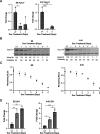Loss of Grp170 results in catastrophic disruption of endoplasmic reticulum function
- PMID: 38446639
- PMCID: PMC11064666
- DOI: 10.1091/mbc.E24-01-0012
Loss of Grp170 results in catastrophic disruption of endoplasmic reticulum function
Abstract
GRP170 (Hyou1) is required for mouse embryonic development, and its ablation in kidney nephrons leads to renal failure. Unlike most chaperones, GRP170 is the lone member of its chaperone family in the ER lumen. However, the cellular requirement for GRP170, which both binds nonnative proteins and acts as nucleotide exchange factor for BiP, is poorly understood. Here, we report on the isolation of mouse embryonic fibroblasts obtained from mice in which LoxP sites were engineered in the Hyou1 loci (Hyou1LoxP/LoxP). A doxycycline-regulated Cre recombinase was stably introduced into these cells. Induction of Cre resulted in depletion of Grp170 protein which culminated in cell death. As Grp170 levels fell we observed a portion of BiP fractionating with insoluble material, increased binding of BiP to a client with a concomitant reduction in its turnover, and reduced solubility of an aggregation-prone BiP substrate. Consistent with disrupted BiP functions, we observed reactivation of BiP and induction of the unfolded protein response (UPR) in futile attempts to provide compensatory increases in ER chaperones and folding enzymes. Together, these results provide insights into the cellular consequences of controlled Grp170 loss and provide hypotheses as to why mutations in the Hyou1 locus are linked to human disease.
Figures







Update of
-
Loss of Grp170 results in catastrophic disruption of endoplasmic reticulum functions.bioRxiv [Preprint]. 2023 Oct 20:2023.10.19.563191. doi: 10.1101/2023.10.19.563191. bioRxiv. 2023. Update in: Mol Biol Cell. 2024 Apr 1;35(4):ar59. doi: 10.1091/mbc.E24-01-0012. PMID: 37905119 Free PMC article. Updated. Preprint.
References
-
- Anttonen AK, Mahjneh I, Hämäläinen RH, Lagier-Tourenne C, Kopra O, Waris L, Anttonen M, Joensuu T, Kalimo H, Paetau A, et al. (2005). The gene disrupted in Marinesco-Sjögren syndrome encodes SIL1, an HSPA5 cochaperone. Nat Genet 37, 1309–1311. - PubMed
-
- Appenzeller-Herzog C, Ellgaard L (2008). The human PDI family: versatility packed into a single fold. Biochim Biophys Acta 1783, 535–548. - PubMed
-
- Balchin D, Hayer-Hartl M, Hartl FU (2016). In vivo aspects of protein folding and quality control. Science 353, aac4354. - PubMed
MeSH terms
Substances
Grants and funding
LinkOut - more resources
Full Text Sources
Molecular Biology Databases
Research Materials
Miscellaneous

